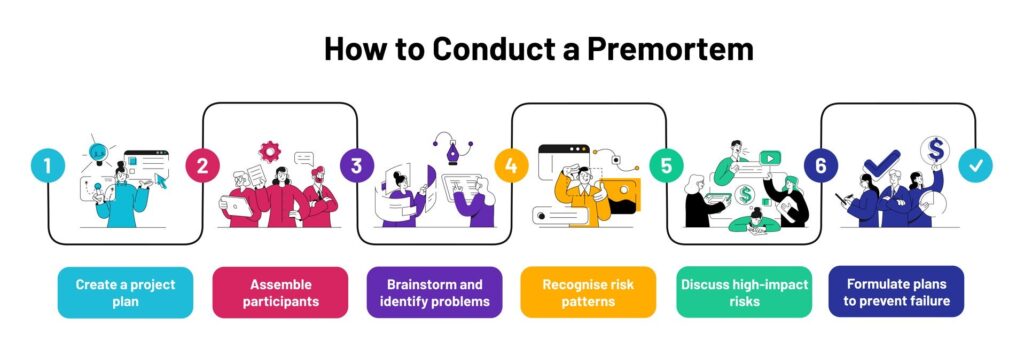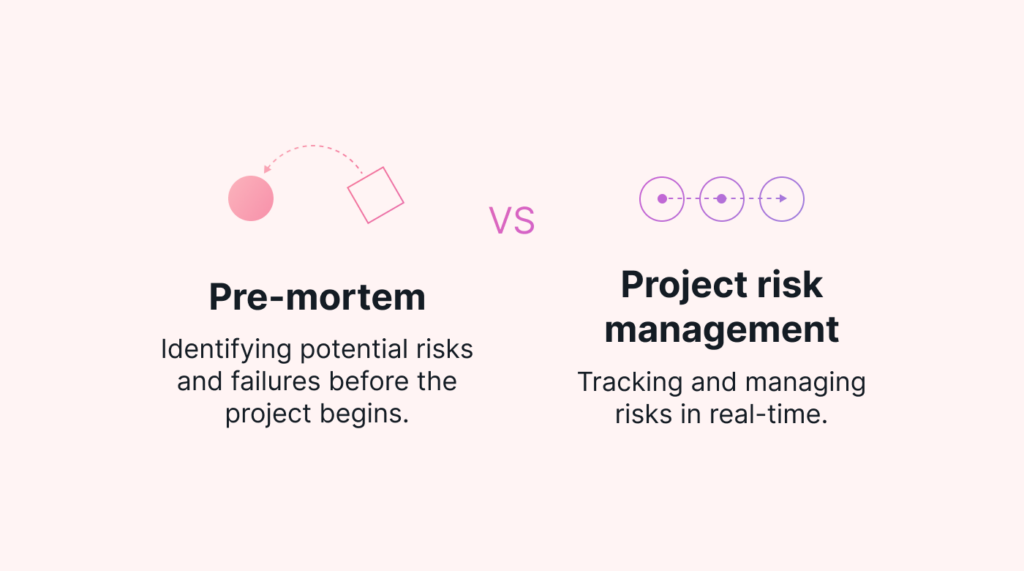Article

Premortems in Project Lifecycle: A CTOs Project Management Playbook
In a high-stakes project management playbook where the margin for error is slim, the ability to anticipate and address risks before they derail a project can be the difference between success and failure. The premortem, an innovative risk assessment technique, offers a fresh perspective on identifying and mitigating potential pitfalls. This approach not only challenges conventional risk management practices but also empowers teams to proactively address issues before they arise.
As part of our project management playbook series, let’s analyze how to conduct a premortem, benefits, challenges, and trends of the practice.
What is a premortem in a project lifecycle?
A premortem is a strategic exercise designed to preemptively identify potential risks by imagining a project’s failure before it even starts. The goal is to work backward from this hypothetical failure to uncover the factors that contributed to it. This technique leverages “prospective hindsight” to offer a unique and actionable perspective on potential challenges.

[Image Source: Tech.co]
The premortem process
- Preparation: Before the premortem meeting, ensure that all participants have a clear understanding of the project’s objectives, scope, and plan. The leader of the session—whether it’s the project manager or another designated individual—begins by announcing that the project has failed. This declaration sets the stage for the brainstorming session.
- Brainstorming: Participants individually or in groups brainstorm potential reasons for the project’s failure. This phase encourages creativity and thoroughness, prompting team members to consider every possible failure point, no matter how unlikely or unconventional.
- Sharing and analysis: Each participant shares one reason for failure, ensuring that all points are unique. These reasons are compiled into a central document for analysis. The project manager or team leader reviews the list to identify recurring themes and high-priority risks.
- Action planning: Based on the identified risks, the team develops strategies to address each issue. This may involve revising the project plan, implementing new safeguards, or assigning specific tasks to mitigate potential problems. The objective is to create a comprehensive action plan that enhances the project’s chances of success.
Why conduct a premortem?
One of the primary benefits of a premortem is its ability to combat overconfidence. At the outset of a project, stakeholders may have an overly optimistic view of its success, leading to the neglect of potential risks. By envisioning failure and exploring the reasons behind it, the premortem forces the team to confront and address possible weaknesses.
Moreover, traditional risk assessments often rely on speculative analysis, which can lead to incomplete or superficial risk identification. The premortem approach, however, encourages a deeper exploration of potential issues by starting from the end point—failure. This method provides a more comprehensive understanding of the risks and challenges that could impact the project.
Also, a premortem creates a safe space for team members to voice concerns and share insights without fear of judgment. This open communication is crucial for uncovering hidden risks and generating creative solutions. By valuing and incorporating diverse perspectives, the premortem fosters a collaborative environment that strengthens the project plan.
Big tech’s use cases for adoption of premortem analysis
One of the most compelling examples of premortem analysis in action comes from Google. The company has been known for its innovative approach to project management and risk assessment. Google’s use of premortem analysis, particularly in its software development projects, highlights its commitment to proactive risk management.
A notable instance is Google’s development of its cloud-based AI and machine learning tools. During the planning phase, Google’s project teams conducted premortem sessions to identify potential risks such as integration challenges, data security issues, and scalability problems. By adopting this approach, Google was able to address these risks early, leading to the successful launch of several AI products and enhancements to its cloud services. This proactive strategy contributed significantly to the product’s success and minimized disruptions during the rollout.
Microsoft has also embraced the premortem technique as part of its project planning and risk management processes. For example, when launching new features for its Azure cloud platform, Microsoft’s teams used premortem analysis to anticipate potential integration issues, performance impacts, and user adoption challenges. This forward-thinking approach allowed Microsoft to make necessary adjustments and ensure that their new features met high performance and reliability standards.
Premortem vs. risk assessment: What’s the difference?
When navigating the complexities of project management, understanding the tools at your disposal for risk management is crucial. Among these tools, premortems and risk assessments stand out as essential methods for identifying and mitigating risks. However, they differ significantly in their approach and application.
Premortem analysis is a proactive technique used before a project begins. The core concept of a premortem is to envision the project’s failure and work backward to understand what could have led to that outcome. This method emphasizes anticipating potential problems that might not be apparent through conventional risk assessment approaches.

[Image Source: Motion]
The primary goal of a premortem is to identify issues that may not be immediately obvious. It focuses on exploring the “what-ifs” of failure, which can reveal risks that traditional risk assessments might miss. By assuming failure, a premortem encourages team members to voice concerns they might otherwise withhold for fear of being negative. This open dialogue helps in identifying potential issues that could derail the project.
The outcome of a premortem is a detailed list of potential failure points and their impacts. This comprehensive view allows for early intervention and the development of mitigation strategies before actual issues arise. By addressing potential problems early in the planning phase, teams can implement preventive measures and contingency plans to manage identified risks effectively.
Risk assessment, on the other hand, is a more traditional method used during the project planning process. It involves evaluating potential risks based on their likelihood and impact, using historical data and predictive models to inform risk management strategies.
Risk assessment focuses on identifying risks, analyzing their likelihood, and assessing their potential impact on the project. It uses historical data, statistical models, and expert judgment to predict which risks are most probable and how severe their effects might be. This process often includes both quantitative measures (such as probability and impact scores) and qualitative analysis (such as expert opinions and scenario planning) to develop a risk profile for the project.
The emphasis is on prioritizing risks based on their potential impact and likelihood. This helps in allocating resources effectively to manage the most critical risks.
Risk assessment aims to create a risk management plan that outlines strategies for mitigating, transferring, or accepting risks. This plan guides how to respond to risks that are likely to occur. The result of a risk assessment is a structured risk management plan that includes detailed strategies for dealing with identified risks. This plan helps ensure that risks are managed proactively and effectively throughout the project lifecycle. By prioritizing risks, risk assessments assist in directing resources and efforts towards the most significant threats, optimizing risk management efforts.
In a nutshell, while risk assessment and premortem analysis both aim to manage project risks, they do so through different lenses.
Risk assessment is grounded in evaluating potential risks based on their likelihood and impact, using historical data and predictive models. It is a systematic approach focused on prioritizing and managing risks effectively.
Premortem analysis takes a more imaginative and proactive approach by assuming project failure and working backward to identify potential causes. It emphasizes uncovering hidden risks and fostering open discussion to address issues before they materialize. Combining these approaches allows project managers and CTOs to create a more comprehensive risk management strategy, ensuring that potential issues are identified and addressed proactively.
Recent trends in premortem analysis CTOs should take into account
The premortem technique has evolved significantly, adapting to the changing landscape of project management and technology. Let’s explore some of the key trends shaping the way premortems are applied in modern projects.
Integration with agile methodologies
In recent years, the premortem technique has been increasingly integrated into agile development practices. Agile teams, known for their iterative and adaptive approach, use premortems to anticipate and address risks in each sprint or iteration. This integration enhances the agile process by proactively managing risks and ensuring that potential issues are addressed before they impact the development cycle.
Use of technology in premortems
Modern technology has also enhanced the premortem process. Tools like project management software and risk management platforms allow teams to document, analyze, and track risks more efficiently. Advanced analytics and AI-driven insights can further refine the premortem process, providing deeper insights into potential risks and helping teams develop more effective mitigation strategies.
Focus on behavioral insights
Recent trends in risk management emphasize the importance of psychological safety in premortem sessions. Techniques are being developed to ensure that all team members feel comfortable sharing their concerns and insights. This focus on behavioral insights helps in uncovering potential risks that might be overlooked in a less open environment.
The premortem technique offers a powerful approach to risk management in software development. By envisioning project failure and working backward to identify potential causes, teams can develop robust plans to mitigate risks and increase the likelihood of success.
For modern CTOs and IT directors, integrating premortem analysis into project planning can transform risk management practices, leading to more successful project outcomes and a stronger foundation for future initiatives.
In brief
In a rapidly evolving technological landscape, where the stakes are high and the margin for error is slim, the premortem provides a proactive and insightful approach to managing risks. By adopting this technique, project managers and development teams can enhance their planning processes, foster open communication, and ultimately drive more successful software projects.